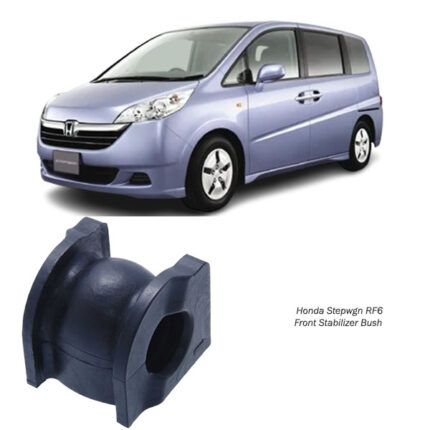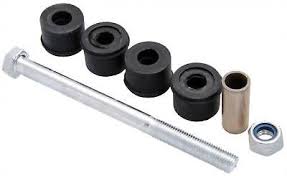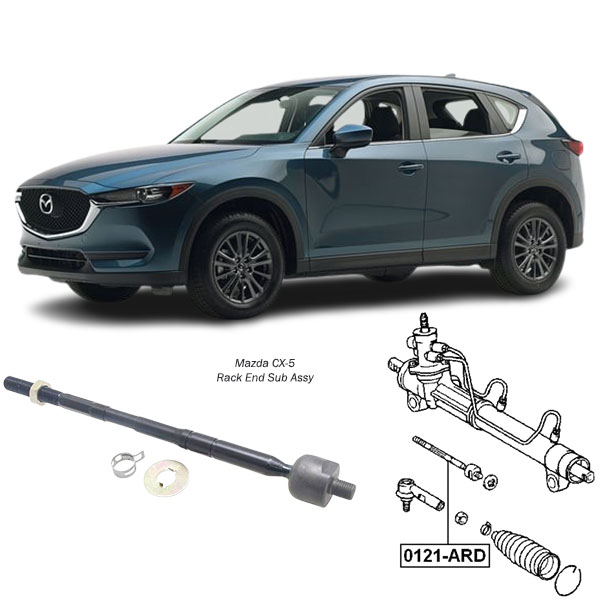-10%
Get Mazda CX-5 Rack End Sub Assy 0122-ARD in Kenya
The rack end sub-assembly, also known simply as rack end or tie rod end, is a critical component of a vehicle’s steering system that connects the steering rack or gearbox to the steering knuckle. This linkage enables the transmission of steering input from the driver to the wheels, allowing for controlled movement and direction changes. Here, we delve into the functions, components, types, importance, signs of issues, replacement considerations, and maintenance tips related to rack end sub-assemblies.
Functions and Components of Rack End Sub Assy
- Steering Linkage: The primary function of a rack end sub-assembly is to transmit steering inputs from the steering rack to the steering knuckle. It converts rotational movement from the steering gearbox or rack into lateral movement of the wheels, enabling steering control.
- Adjustment and Alignment: Rack ends play a crucial role in adjusting the toe alignment of the vehicle’s front wheels. They allow for fine-tuning of the alignment angles to ensure even tire wear and optimal handling characteristics.
- Support and Durability: Rack ends are designed to withstand significant forces and vibrations encountered during steering. They are equipped with ball joints or bushings that allow for smooth movement while maintaining structural integrity.
- Safety and Stability: Properly functioning rack end sub-assemblies contribute to vehicle stability and safety by ensuring responsive steering and maintaining predictable handling characteristics.
Types of Rack End Sub Assemblies
- Inner and Outer Rack Ends: In vehicles with rack-and-pinion steering systems, rack ends are typically categorized into inner and outer tie rod ends. The inner tie rod end connects to the steering rack or gearbox, while the outer tie rod end connects to the steering knuckle.
- Adjustable vs. Non-adjustable: Some rack ends are adjustable, allowing for toe alignment adjustments without replacing the entire assembly. Non-adjustable rack ends require replacement if alignment settings cannot be corrected through adjustment.
- OEM vs. Aftermarket: Original equipment manufacturer (OEM) rack end sub-assemblies are designed to meet specific vehicle manufacturer standards and specifications. Aftermarket options may offer performance enhancements or cost savings but should be chosen carefully to ensure compatibility and quality.
Importance of Rack End Sub Assy
Rack end sub-assemblies are crucial for several reasons:
- Steering Precision: They play a direct role in steering response and precision, translating driver input into smooth and controlled wheel movements.
- Alignment Control: Rack ends help maintain proper wheel alignment, ensuring even tire wear and maximizing tire longevity.
- Safety: Properly functioning rack end sub-assemblies contribute to vehicle stability and handling, crucial for safe driving in various road conditions.
Signs of Issues with Rack End Sub Assy
- Loose Steering: Excessive play or looseness in the steering wheel may indicate worn or damaged rack end sub-assemblies, affecting steering responsiveness and control.
- Uneven Tire Wear: Misaligned or worn rack ends can cause uneven tire wear patterns, particularly on the inner or outer edges of the tires.
- Clunking or Knocking Noises: Audible clunking or knocking noises when turning the steering wheel, especially at low speeds or over bumps, may indicate loose or worn rack end ball joints or bushings.
- Steering Wheel Vibration: Vibrations felt through the steering wheel, particularly during acceleration or braking, can signal issues with rack end sub-assemblies affecting steering stability.
Replacement Considerations
- Complete Assembly vs. Individual Components: Depending on the extent of wear or damage, you may replace the entire rack end sub-assembly or individual components such as ball joints, bushings, or boots.
- Quality Parts: Use high-quality OEM or aftermarket rack end sub-assemblies and components from reputable manufacturers to ensure proper fitment, durability, and performance.
- Professional Installation: For complex repairs or if you’re unsure about the process, seek assistance from a qualified mechanic or automotive technician experienced in steering system repairs.
- Alignment Check: After replacing rack end sub-assemblies or making adjustments, perform a wheel alignment to ensure proper suspension geometry and optimize handling and tire wear.
Maintenance Tips
- Regular Inspection: Include rack end sub-assemblies in routine steering and suspension inspections, checking for signs of wear, movement, or abnormal noise.
- Greasing and Lubrication: Lubricate rack end ball joints, bushings, and pivot points as recommended by the vehicle manufacturer to ensure smooth operation and prevent premature wear.
- Avoid Impact and Overloading: Avoid impacts and overloading your vehicle beyond its recommended capacity, as excessive force can accelerate wear on steering components, including rack end sub-assemblies.
Follow us on Facebook for more parts.



